目录
- 一、交集操作
- 1.使用intersection()求交集
- 2.使用位运算&符求交集
- 3.intersection_update()方法
- 4.使用intersection()方法
- 二、并集操作
- 1.使用union()求并集
- 2.使用逻辑或|求并集
- 3.使用update()求并集,只能作用域可变集合
前言:
集合这种数据类型和我们数学中所学的集合很是相似,数学中堆积和的操作也有交集RTkrGbnRM,并集和差集操作,python集合也RTkrGbnRM是一样。

一、交集操作
1.使用intersection()求交集
可变集合和不可变集合求交集的时候,用什么集合调用交集方法,返回的结果就是什么类型的集合。
set7 = {'name', 18, 'python2', 'abc'}
set8 = frozenset({'name', 19, 'python3', 'abc'})
res = set7.intersection(set8) # {'abc', 'name'} <class 'set'>
print(res, type(res))
res = set8.intersection(set7) # frozenset({'abc', 'name'}) <class 'frozenset'>
print(res, type(res))
返回结果:
{'abc', 'name'} <class 'set'>
frozenset({'abc', 'name'}) <class 'frozenset'>编程客栈
2. 使用位运算&符求交集
set5 = {'name', 18, 'python2', 'abc'}
set6 = {'name', 19, 'python3', 'abc'}
set7 = {'name', 18, 'python2', 'abc'}
set8 = frozenset({'name', 19, 'python3', 'abc'})
res = set5 & set6
print(res, type(res))
res = set7 & set8
print(res, type(res))
res = set8 & set7 # 谁在前,返回结果就和谁是同样类型的集合
print(res, type(res))
返回结果:
{'abc', 'name'} <class 'set'>
{'abc', 'name'} <class 'set'>frozenset({'abc', 'name'}) <class 'frozenset'>
3.intersection_update()方法
使用此方法计算出交集之后会把结果赋值给原有的集合,属于一种更改,所以不适用于不可变集合
set7 = {'name', 18, 'python2', 'abc'}
set8 = frozenset({'name', 19, 'python3', 'abc'})
res = set7.intersection_update(set8) # 没有返回值
print(set7, type(set7)) # 没有返回值,直接打印被赋值集合
res = set8.intersection_update(set7) # 不可变集合没有intersection_update方法
print(res, type(res))
返回结果:
{'abc', 'name'} <class 'set'>
AttributeError: 'frozenset' object has no attribute 'intersection_update'
4.使用intersection()方法
使用此方法求集合和其他数据类型的交集时intersection()会把其他数据类型直接转为集合。
str1 = 'python'
list1 = [1, 2, 3, 18]
tup1 = (1, 2, 3, 18)
dict1 = {'name': 'Tom', 'age': 18, 'love': 'python'}
set10 = {'name', 18, 'python', 'abc', 'p'}
print(set10.intersection(str1))
# 返回:{'p'}而不是{'python'},因为str1转成集合为:{'y', 't', 'p', 'o', 'n', 'h'}
print(set10.intersection(list1))
print(set10.intersection(tup1))
print(set10.intersection(dict1))
返回结果:
{'p'}
{18}{18}{'name'}
二、并集操作
1.使用union()求并集
set5 = {'name', 18, 'python2', 'abc'}
set6 = {'name', 19, 'python3', 'abc'}
res 编程客栈= set5.union(set6)
print(res, type(res))
返回结果:
{'python2', 'abc', 18, 19, 'python3', 'name'} <class 'set'>
2.使用逻辑或 | 求并集
s编程客栈et5 = {'name', 18, 'python2', 'abc'}
set6 = {'name', 19, 'python3', 'abc'}
res = set5 | set6
print(res, type(res))
返回结果:
{'abc', 'python2', 'name', 'python3', 18, 19} <class 'set'>
3.使用update()求并集,只能作用域可变集合
set5 = {'name', 18, 'python2', 'abc'}
set6 = {'name', 19, 'python3', 'abc'}
res = set5.update(set6) # 有黄色波浪线表示这个函数没有返回值
print(set5, type(set5))
返回结果:
{'python2', 'python3', 18, 'abc', 19, 'name'} <class 'set'>
到此这篇关于Python集合set的交集和并集操作方法小的文章就介绍到这了,更多相关Python集合set内容请搜索我们以前的文章或继续浏览下面的相关文章希望大家以后多多支持我们!









 加载中,请稍侯......
加载中,请稍侯......
精彩评论